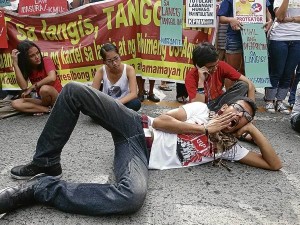
In the perception war that is Philippine politics, President Noynoy Aquino has been looked at by critics as lackadaisical, laid back, do nothing.
And thus in the recent months, in very Pinoy fashion, a new word has been hatched to describe the presidential work style: Noynoying.” It has come to mean a carefree way of dealing with the problems of the state.
Noynoying began to catch public interest as a protest gimmick that young activists used to denounce what they regard as lack of action by the government on the issues of disaster response and rising oil prices.
It is a play on “planking” (meaning to lie vertically, face down) and Aquino’s nickname, “Noynoy.”
The term caught fire.
Party-list Representative Teddy Casino charged House Speaker Feliciano Belmonte Jr. as “Noynoying” on the bill to abolish value-added taxes imposed on petroleum products. Labor and Philippine embassy officials were criticized by a Migrante officer to be “Noynoying daily,” that is, procrastinating in providing needed assistance over the abuse and labor malpractices committed against OFWs. The government has also been accused of “Noynoying” or not working to stop tuition fee hikes.
P-noy on Noynoying
President Aquino reacted to the Noynoying charges by pointing to recent indicators the Philippine economy is on a growth trajectory unprecedented within recent memory. The implication is that his work style—however it is called—is working.
After decades of underperforming, the economy has shown signs of steady improvement under his leadership, he has told his critics.
He cited a series of international credit rating upgrades and the rise of the Philippine stock market to record highs as evidence.
He also referred to inroads made in luring foreign businesses to invest in the Philippines, in keeping poor children in school through an incentives scheme, in implementing the anti-graft campaign, and in cutting down on government spending.
To charges he was remiss when he slowed down government expenditures last year when pump-priming was what was needed to boost GDP growth, the President said his prudent monetary policies won had won approval from many quarters, including the international finance community.
One of the endorsements he must have had in mind was the World Bank assessment that the economy was in good shape, with inflation stable at around 2.7 per cent, manageable government finances, and a well-focused social protection system.
Growth despite Noynoying
In the words of World Bank country director Motoo Konishi: “Besides having strong macroeconomic fundamentals, the country is benefiting from political stability and a popular government seen by many as strongly committed in reducing poverty.”
Recently, Global credit watchers Moody’s Investor Service as well as Standard and Poor’s also cited improvements in the country’s economic performance and hinted that it might soon make ‘investment grade’ in credit rating. It may be recalled Standard and Poor’s improved its outlook on the country from “stable” to “positive” last December.
Finance Secretary Cesar Purisima predicted an investment grade for the country was certain within the term of President Aquino.
As though to confirm the country’s investment-worthiness, US-based financial multinational Citibank N.A. revealed its plan to expand lending business here and relocate some of its offshore-based services in the country.
“Citi considers the Philippines as a key growth area, given its economic growth potential and good-quality labor force,” Citibank Chief Executive Eugene McQuade, who was here for a series of meetings, said recently.
At home, local businessmen seem increasingly optimistic about their prospects, as shown by the latest Bangko Sentral ng Pilipinas Business Expectation Survey, citing new contracts and projects, sound macroeconomic fundamentals, steady investment inflows, and political stability as among the triggers of growth.
Some of them have put their money where their mouth is.
Notably, Ayala Land Inc. announced its plans to invest over $1.4 billion in the next five years in projects within Makati, the country’s financial district.
Ayala Land president Antonino Aquino explained that “the economy is on a positive track…that’s why we’re aggressive in our investment.”
The other side of Noynoying
Others have put forward their own takes on ‘Noynoying.’
Loreta Rafisura, Cagayan de Oro-based social entrepreneur, president of Salay Handmade Paper Industries Inc., answered in an online interview: “Noynoying is doing what he must do within the limits of his capacity and not pretending that being President is the only thing he does while he is in office. Noynoying is trying one’s best but at the same time accepting his limitations because he is human after all, not superman. Noynoying is being at home in his native tongue and so proud of it, too, using it every chance he gets to communicate with his people.”
Well-respected writer-artist Gilda Cordero-Fernando wrote in her Sunday Inquirer column: “Noynoying also means…trying to govern a country that has so many opinions. Noynoying is knowing how to tell the truth. He never said he was poor, he never wore a wig, he never said he loved Corona. Noynoying means never to stop believing in the possibility of a clean government.”
Transportation Secretary Manuel Roxas II also has his own definition of Noynoying. For him, he said in a speech, it means somebody who is careful about the people’s money, who does not borrow and spend recklessly.
Awarded writer Alex Almario, blogging in the Philippine Online Chronicles, observed he has heard the term being used in the office, among friends and relatives, to mean to take a break whenever people feel tired and stressed out, as in “hay…pagod na ako, gusto kong makapag-Noynoying naman.”
This implies that the pejorative word that “Noynoying” is now can eventually be turned to advantage by a good PR practitioner.
These takes give Noynoying a positive spin. They seem to be saying: “If this be Noynoying, bring it on.”
(The author handles the Media Bureau of the Small Enterprises Research and Development Foundation (Serdef), known as a resource hub for micro, small and medium enterprises. For articles and tips on entrepreneurship and small enterprise development, including a beginner’s kit, visit the Serdef website at www.serdef.org.)

